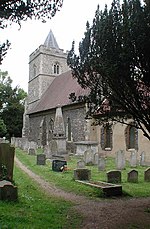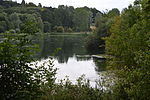East Herts Miniature Railway
7¼ in gauge railways in EnglandEngland rail transport stubsMiniature railways in the United KingdomTourist attractions in HertfordshireUse British English from January 2018

The East Herts Miniature Railway (EHMR) is situated in the Van Hage Garden Centre, Great Amwell near Ware, Hertfordshire. It opened in 1978 and by 2006 had carried 1 million passengers. As of 2022, the railway has carried more than 2 million people over its forty-year history. The railway is popular with locals.The current length of the track is around 1/4 of a mile. The site comprises a station with canopy and booking office, bridge, engine shed, tunnel, turntable, signal box (with ex London Underground Westinghouse 'B' style lever frame from Hyde Park Corner), steaming bays, level crossing, water tower and workshop.
Excerpt from the Wikipedia article East Herts Miniature Railway (License: CC BY-SA 3.0, Authors, Images).East Herts Miniature Railway
Walnut Tree Walk, East Hertfordshire Great Amwell
Geographical coordinates (GPS) Address Nearby Places Show on map
Geographical coordinates (GPS)
| Latitude | Longitude |
|---|---|
| N 51.7935 ° | E -0.0218 ° |
Address
East Herts Miniature Railway
Walnut Tree Walk
SG12 9RA East Hertfordshire, Great Amwell
England, United Kingdom
Open on Google Maps










